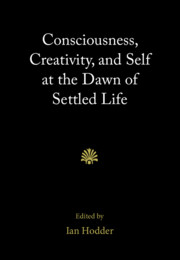Book contents
- Consciousness, Creativity, and Self at the Dawn of Settled Life
- Consciousness, Creativity, and Self at the Dawn of Settled Life
- Copyright page
- Contents
- Contributors
- Acknowledgments
- Part I Introduction to the Themes, Site, and Region
- Part II Higher Levels of Consciousness
- Part III Greater Innovation and Creativity
- Part IV Greater Awareness of an Integrated Personal Self
- 10 Personal Memory, the Scaffolded Mind, and Cognitive Change in the Neolithic
- 11 Adorning the Self
- 12 From Parts to a Whole? Exploring Changes in Funerary Practices at Çatalhöyük
- 13 New Bodies: From Houses to Humans at Çatalhöyük
- Notes
- Index
- References
13 - New Bodies: From Houses to Humans at Çatalhöyük
from Part IV - Greater Awareness of an Integrated Personal Self
Published online by Cambridge University Press: 22 February 2020
- Consciousness, Creativity, and Self at the Dawn of Settled Life
- Consciousness, Creativity, and Self at the Dawn of Settled Life
- Copyright page
- Contents
- Contributors
- Acknowledgments
- Part I Introduction to the Themes, Site, and Region
- Part II Higher Levels of Consciousness
- Part III Greater Innovation and Creativity
- Part IV Greater Awareness of an Integrated Personal Self
- 10 Personal Memory, the Scaffolded Mind, and Cognitive Change in the Neolithic
- 11 Adorning the Self
- 12 From Parts to a Whole? Exploring Changes in Funerary Practices at Çatalhöyük
- 13 New Bodies: From Houses to Humans at Çatalhöyük
- Notes
- Index
- References
Summary
The subject of this chapter consists of a relational and ontological approach to the fundamental social changes that occurred at Çatalhöyük from 6,500 BCE and the revolutions in notions of selfhood and autonomy that followed. Previous explorations of personhood in the literature on the Neolithic in Southwest Asia, however, have relied heavily on post-Enlightenment Western conceptual dichotomies, most principally nature/culture. This opposition rematerialises as other dualisms, such as between the assumed converse conditions of humanity and animality, wild and domestic, hunter-gatherer and agriculturalist and so on, whereby controlling and taming the ‘wild’, people in turn are envisaged to have tamed and controlled both society and themselves. These notions essentially reiterate a common and archaic canon of thought. It is one concerned with the evolution of hominids to humans or, synonymously, with the transition from hunting to industry and the subordination of nature by human reason (Engels 1934, 34, 308, 178; Fried 1967; Glacken 1967; Service 1962). This convention, espoused in the middle of the last century by Braidwood (1957, 22) and Childe (1942, 55), essentially questions the humanity of pre-agricultural peoples, considered to be more homo sapiens than ‘person’. Through the revolution of subsistence, architecture, symbolism or sedentism, Neolithic peoples are portrayed as conquering some sort of intellectual and historical hurdle. These considerations find their most explicit expression in recent cognitivist approaches, which contend that the cultural transformations of the period were effected by a fundamental overhaul of the limits of the human mind (Mithen 1996). Living in larger social groups and engaging materially with monumental architecture is claimed to have engendered ‘symbolic storage’ and the accumulation of cognitive capital (Watkins 2004, 2005, 2006, 2008, 2010a, 2010b, 2012, 2014, 2016). This enabled humans to process greater and more complex volumes of information and externalise, represent and culturally construct the world around them in ways that were previously biologically inaccessible to our Palaeolithic forebears. As a consequence, Neolithic peoples are portrayed as culturally and intellectually similar to modern humans in fundamental ways that our hunting and gathering ancestors were not. By extension, one could apply the proposition to extant small-scale indigenous human groups, resulting in the same neo-evolutionary assumptions of biological inferiority prevalent in early twentieth-century anthropology.
- Type
- Chapter
- Information
- Consciousness, Creativity, and Self at the Dawn of Settled Life , pp. 273 - 288Publisher: Cambridge University PressPrint publication year: 2020



